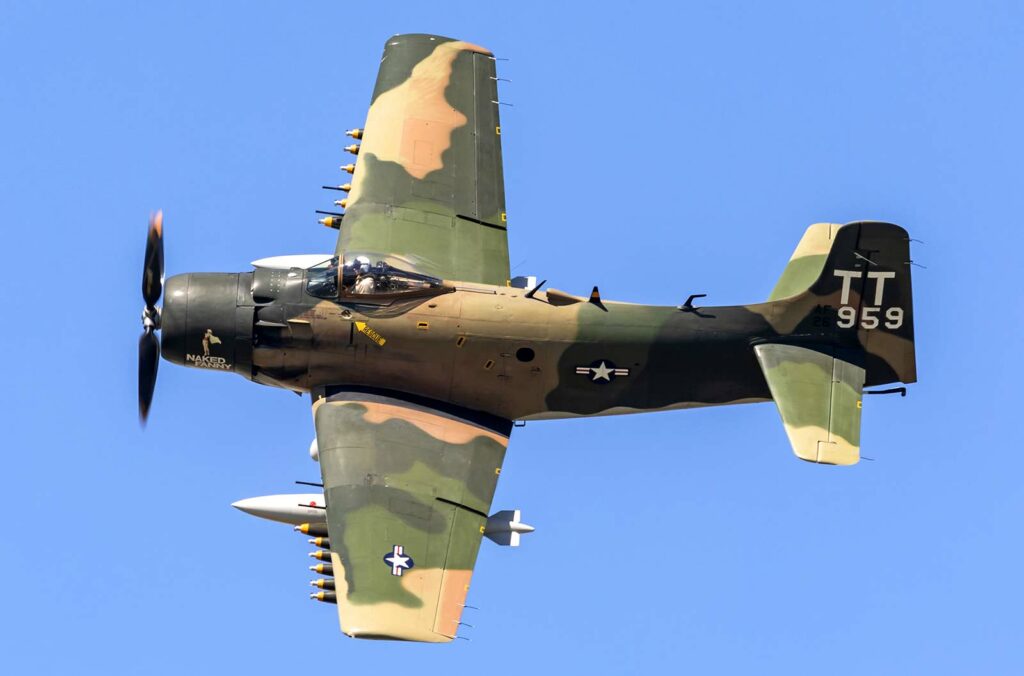The Douglas A-1 Skyraider, a post-WWII American single-seat attack aircraft, known for its heavy payload capacity, versatility, and piston-powered longevity.
This article delves into the Douglas A-1 Skyraider, a significant post-WWII American attack aircraft. It covers the historical context and objectives behind its development, emphasizing its role in filling the need for a powerful, carrier-based attack plane. The design section discusses its technical aspects and the trade-offs involved. A detailed performance analysis compares it to contemporary aircraft, highlighting its unique capabilities. The military use and combat section provides an in-depth look at its armament, operational roles, and effectiveness in various conflicts, culminating in an overview of its enduring legacy in aviation history.
The Douglas A-1 Skyraider, developed shortly after World War II, emerged as a versatile and powerful attack aircraft, serving with distinction in various roles across multiple conflicts.

History of the Development of the Douglas A-1 Skyraider:
The development of the A-1 Skyraider was initiated in the immediate aftermath of World War II. The United States Navy sought a new, more powerful carrier-based attack aircraft to replace older WWII models. The Douglas Aircraft Company, under the direction of Ed Heinemann, took up this challenge.
The program aimed to create an aircraft capable of delivering a sizable payload over long distances, while also being maneuverable and robust enough for carrier operations. The first flight of the Skyraider occurred on March 18, 1945. The Skyraider did not have a specific NATO nickname, as it predated the standard NATO reporting name system.
Design of the Douglas A-1 Skyraider:
The design of the A-1 Skyraider was a blend of traditional and innovative elements. It had a wingspan of 50 feet 9 inches (15.5 meters) and a length of 38 feet 10 inches (11.8 meters). The aircraft was powered by a Wright R-3350 Duplex-Cyclone radial engine, capable of producing 2,700 horsepower.
The Skyraider’s design allowed for an impressive payload capacity, capable of carrying up to 8,000 pounds (3,630 kilograms) of ordnance, including bombs, rockets, and gun pods. It also featured 15 hardpoints for weapons carriage.
Despite its capabilities, the Skyraider had limitations. As a propeller-driven aircraft, it was slower and less agile than contemporary jets. However, its robustness, payload capacity, and range were significant advantages.
Performance of the Douglas A-1 Skyraider:
In terms of performance, the Skyraider was remarkable for its era. It could reach a top speed of 322 mph (518 km/h) and had a range of 1,300 miles (2,092 kilometers) without external tanks. Its service ceiling was 26,000 feet (7,925 meters).
Compared to jet-powered attack aircraft, the Skyraider was slower but its payload capacity, loiter time, and versatility in carrying a diverse range of weapons were unparalleled at the time.

Military Use and Combat of the Douglas A-1 Skyraider:
The A-1 Skyraider’s military career was distinguished and varied. Its armament included four 20 mm M2 cannons, in addition to its ability to carry a mix of bombs, rockets, and other ordnance. It saw extensive use in the Korean War and the Vietnam War.
In Korea, it performed close air support, interdiction, and rescue missions. In Vietnam, its ability to deliver precise strikes and provide close air support in dense jungle environments was highly valued. The Skyraider was involved in notable operations like the rescue of downed airmen.
It faced competition from faster jet aircraft but remained relevant due to its payload capacity and endurance. The Skyraider was also operated by other countries, including France and South Vietnam.
The aircraft’s service with the U.S. military ended in the early 1970s, being replaced by more modern jet aircraft like the A-7 Corsair II. However, it continued to serve in other air forces for years after.
The Douglas A-1 Skyraider holds a special place in military aviation history. Its combination of payload capacity, range, and versatility made it an invaluable asset in several conflicts. Despite the advent of jet technology, the Skyraider proved that propeller-driven aircraft could still play a crucial role on the modern battlefield, a testament to its robust design and operational flexibility.
Back to the Warbirds section.